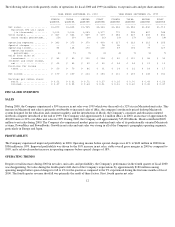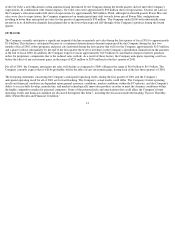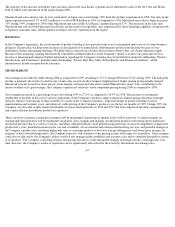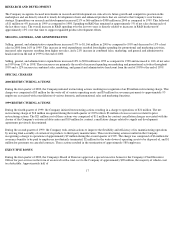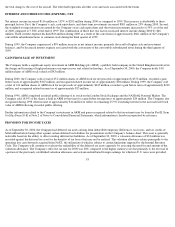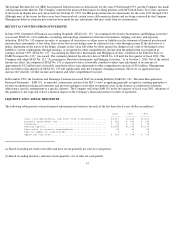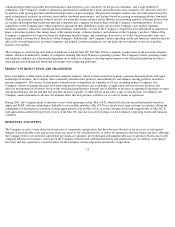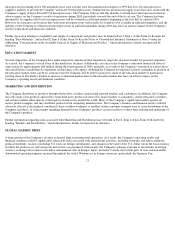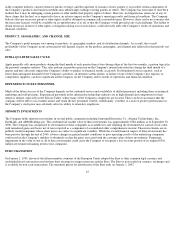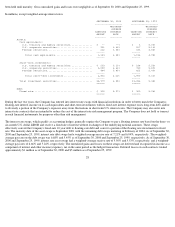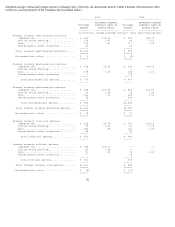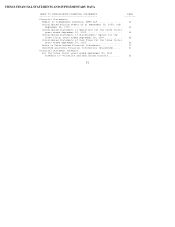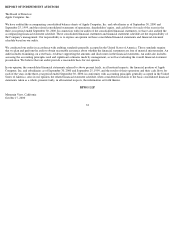Apple 2000 Annual Report Download - page 25
Download and view the complete annual report
Please find page 25 of the 2000 Apple annual report below. You can navigate through the pages in the report by either clicking on the pages listed below, or by using the keyword search tool below to find specific information within the annual report.The Company must order components for its products and build inventory in advance of product shipments. Because the Company's markets
are volatile and subject to rapid technology and price changes, there is a risk the Company will forecast incorrectly and produce or order from
third parties excess or insufficient inventories of particular products. Consistent with industry practice, components are normally acquired
through purchase orders typically covering the Company's requirements for periods from 30 to 130 days. The Company's operating results and
financial condition have been in the past and may in the future be materially adversely affected by the Company's ability to manage its
inventory levels and respond to short-term shifts in customer demand patterns.
The Company ended 2000 with substantially more inventory in its distribution channels than planned due to the lower than expected sell-
through of the Company's products during the fourth quarter. The Company currently anticipates a significant sequential decline in quarterly
net sales during the first quarter of fiscal 2001, in part due to the Company's plan to reduce substantially the level of inventory in its distribution
channels from the amounts at the end of fiscal 2000 to more normal levels by the end of the first quarter.
Many of the Company's products are manufactured in whole or in part by third-party manufacturers. In addition, the Company has outsourced
much of its transportation and logistics management. While outsourcing arrangements may lower the fixed cost of operations, they also reduce
the Company's direct control over production and distribution. It is uncertain what effect such diminished control will have on the quality or
quantity of the products manufactured, or the flexibility of the Company to respond to changing market conditions. Moreover, although
arrangements with such manufacturers may contain provisions for warranty expense reimbursement, the Company may remain at least initially
responsible to the ultimate consumer for warranty service or in the event of product defects. Any unanticipated product defect or warranty
liability, whether pursuant to arrangements with contract manufacturers or otherwise, could adversely affect the Company's future operating
results and financial condition.
Although certain components essential to the Company's business are generally available from multiple sources, other key components
(including microprocessors and application specific integrated circuits ("ASICs")) are currently obtained by the Company from single or
limited sources. Some other key components (including without limitation DRAM, TFT-LCD flat-panel displays, and optical and magnetic
disk drives), while currently available to the Company from multiple sources, are at times subject to industry wide availability and pricing
pressures. In addition, new products introduced by the Company often initially utilize custom components obtained from only one source until
the Company has evaluated whether there is a need for and subsequently qualifies additional suppliers. In situations where a component or
product utilizes new technologies, initial capacity constraints may exist until such time as the suppliers' yields have matured. The Company and
other producers in the personal computer industry also compete for various components with other industries (such as the cellular phone and
automotive industries) that have experienced increased demand for their products. The Company uses some components that are not common
to the rest of the personal computer industry (including certain microprocessors and ASICs). Continued availability of these components may
be affected if producers were to decide to concentrate on the production of components other than those customized to meet the Company's
requirements. If the supply of a key component were to be delayed or constrained on a new or existing product, the Company's results of
operations and financial condition could be adversely affected, depending on the time required to obtain sufficient quantities from the original
source, or, if possible, to identify and obtain sufficient quantities from an alternate source.
The Company's ability to produce and market competitive products is also dependent on the ability and desire of IBM and Motorola, the sole
suppliers of the PowerPC RISC-based microprocessor for the Company's Macintosh computers, to provide the Company with a sufficient
supply of microprocessors with price/performance features that compare favorably to those supplied to the Company's competitors by Intel
Corporation, and other developers and producers of microprocessors used by personal computers using the Windows operating systems. Apple
has been unable to ship Macintosh systems with PowerPC G4
22


